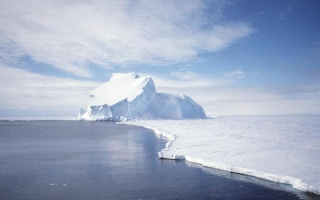Plastic particles have colonised one of the last once-pristine oceans. German scientists sampled sea ice from five locations within the Arctic Circle and counted up to 12,000 microscopic particles per litre of ice.
They have even been able to identify the sources and piece together the journey to the icy fastness. Some tiny lumps of plastic detritus have made their way north from what has become known as the Great Pacific Garbage Patch, a swirling assembly of an estimated 80,000 tons of plastic floating in the ocean across a stretch of water bigger than France.
Other fragments, that began as paint and nylon, date from the invasion of increasingly ice-free Arctic summer waters by more freight ships, and more fishing vessels, the scientists report in the journal Nature Communications.
“During our work, we realised that more than half of the microplastic particles trapped in the ice were less than a twentieth of a millimetre wide, which means they could easily be ingested by Arctic micro-organisms like ciliates, but also by copepods,” said Ilka Peeken, a biologist with the Alfred Wegener Institute.
“
Microplastics are now ubiquitous within the surface waters of the world’s oceans. Nowhere is immune.
Jeremy Wilkinson, sea ice physicist, British Antarctic Survey
“No one can say for certain how harmful these tiny plastic particles are for marine life, or ultimately also for human beings.”
The researchers gathered their samples during three expeditions to the Arctic aboard the icebreaker Polarstern in the spring of 2014 and the summer of 2015, following an ice movement called the Transpolar Drift from Siberia as far as the Fram Strait where warm Atlantic water enters the polar ocean. The Transpolar Drift was first identified by the Norwegian explorer Fridtjof Nansen aboard the Fram, late in the 19th century.
Microplastic particles are defined as 5mm or smaller, and many are measured in millionths of a metre. These are formed by the deterioration of larger pieces of plastic dumped into landfills in billions of tonnes, or released into the waterways and thus into the ocean.
Man-made synthetic polymers are effectively indestructible, and now represent a major source of marine pollution and a constant hazard to wildlife.
More than two-thirds of the particles measured 50 millionths of a metre or smaller. Some were as small as 11 micrometres – one sixth of the diameter of a human hair.
Multiple sources
The researchers identified 17 different types of plastic in the sea ice: from paints, nylon, polyester, cellulose acetate – used in cigarette filters – and the packaging materials polyethylene and polypropylene.
The guess is that the plastics endure in the sea ice for between two and 11 years before melting from their icy packaging in the Fram Strait, to begin sinking in deeper waters. One study recently found 6,500 bits of microplastic per kilogram sampled from the sea floor.
“This is an important finding because it means that they were always present in the water under the ice as it was growing, and drifting, within the Arctic Ocean,” said Jeremy Wilkinson, a sea ice physicist with the British Antarctic Survey, commenting on the study.
“Sea ice grows from the freezing of seawater directly onto the bottom of the ice (i.e. it grows vertically downwards), thus it was incorporating microplastic particles as it grew. It suggests that microplastics are now ubiquitous within the surface waters of the world’s oceans. Nowhere is immune.”
This story was published with permission from Climate News Network.










